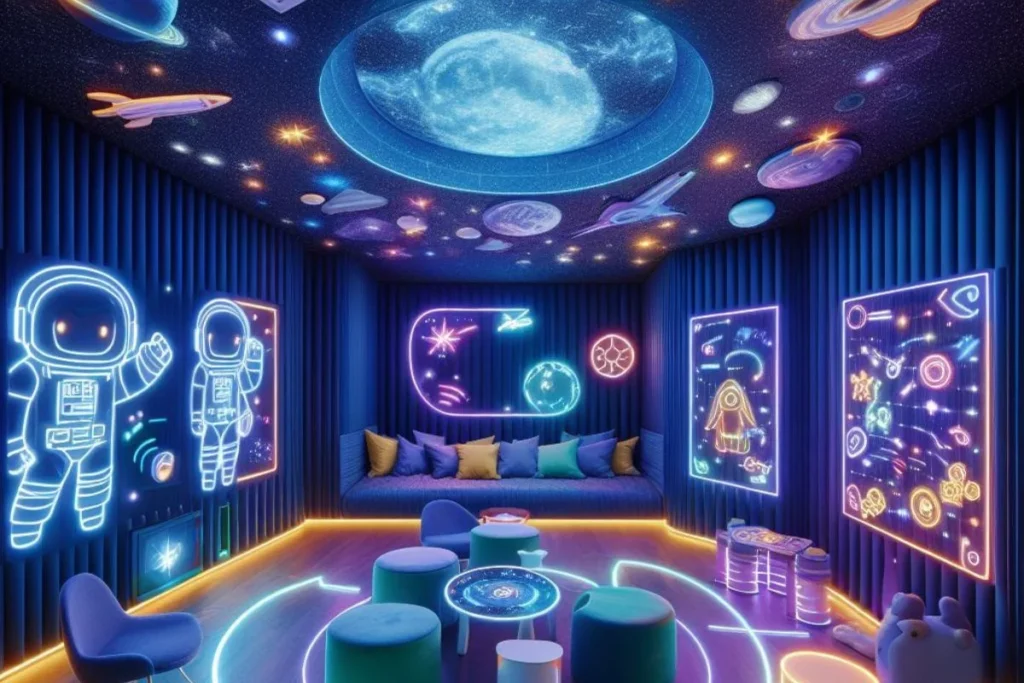Sensory rooms are designed to provide a safe and comfortable environment for individuals who may have sensory processing difficulties. These rooms are often used in schools, hospitals, and therapy clinics to help individuals with sensory challenges regulate their emotions and behavior. A space-themed sensory room can be a fun and engaging way to create a calming and stimulating environment for children.
Benefits of a Space-Themed Sensory Room
A space-themed sensory room can provide a variety of benefits for children, including:
- Stimulating the senses: A sensory room can help stimulate the senses of children with sensory processing difficulties. A space-themed sensory room can provide visual and auditory stimulation through the use of projectors, fiber optic lights, and music.
- Calming the mind: A sensory room can provide a calming environment for children who may be experiencing anxiety or stress. The use of calming colors, soft lighting, and comfortable seating can help promote relaxation.
- Improving focus: A sensory room can help improve focus and attention for children who may have difficulty concentrating. The use of interactive games and activities can help promote engagement and focus.
Essential Components of Sensory Rooms
When creating a space-themed sensory room, it is important to include the following essential components:
- Lighting: Lighting is an important element of a sensory room. A space-themed sensory room can incorporate a variety of lighting options, including fiber optic lights, LED lights, and projectors.
- Textures: The use of different textures can help stimulate the sense of touch. A space-themed sensory room can include soft fabrics, textured walls, and sensory boards.
- Sound: Sound can be an important element of a sensory room. A space-themed sensory room can include music, white noise, and nature sounds.
- Interactive elements: Interactive elements can help promote engagement and focus. A space-themed sensory room can include interactive games, puzzles, and sensory activities.
By incorporating these essential components, a space-themed sensory room can provide a fun and engaging environment for children with sensory processing difficulties.
Designing Your Space Theme
When designing a space-themed sensory room, there are several key elements to consider. By incorporating these elements, you can create a calming and stimulating environment that engages the senses and promotes relaxation.
Choosing a Color Palette
The first step in designing your space-themed sensory room is to choose a color palette. Consider using shades of blue, purple, and black to create a space-like atmosphere. You can also incorporate metallic hues like silver and gold to add a futuristic touch. Avoid bright, bold colors that can be overstimulating.
Incorporating Space Elements
To create an immersive space experience, consider incorporating space-themed elements into your sensory room. Hang glow-in-the-dark stars on the ceiling or walls to create a starry night effect. Use a projector to display images of planets, galaxies, and other space scenes. You can also use space-themed bedding and decor to tie the room together.
Lighting and Visual Effects
Lighting and visual effects are crucial in creating a space-themed sensory room. Use dimmer switches or smart lighting to create a calming atmosphere. Consider using fiber optic lighting to create a starry night effect. You can also use a bubble tube to create a calming visual effect. Avoid strobe lights or other bright, flashing lights that can be overstimulating.
By incorporating these elements into your space-themed sensory room, you can create a calming and stimulating environment for individuals to relax and engage their senses.
Selecting Sensory Equipment
When it comes to creating a space-themed sensory room, selecting the right sensory equipment is crucial. Here are some suggestions for tactile tools, auditory features, and olfactory elements that can enhance the sensory experience:
Tactile Tools
Tactile tools are items that provide a variety of textures and sensations for the user to touch and manipulate. Some tactile tools that can be used in a space-themed sensory room include:
- Moon sand or kinetic sand: These types of sand have a unique texture that is fun to play with and can help with hand-eye coordination.
- Glow-in-the-dark stars: These can be placed on the walls or ceiling to create a space-like atmosphere and can be touched and moved around.
- Astronaut gloves or suits: These can provide a unique tactile experience and can be used for imaginative play.
Auditory Features
Auditory features are sounds or music that can be incorporated into the sensory room to enhance the experience. Here are some ideas for auditory features:
- Space-themed music: This can include instrumental music that creates a space-like atmosphere or songs with space-related lyrics.
- White noise machine: This can be used to create a calming background noise that can help with relaxation.
- Sound effects: These can include sounds like rocket launches, spacewalks, or other space-related noises.
Olfactory Elements
Olfactory elements are scents or smells that can be used in the sensory room to enhance the experience. Here are some suggestions for olfactory elements:
- Essential oils: Scents like lavender or peppermint can be used to create a calming atmosphere, while scents like orange or lemon can be invigorating.
- Scented candles: These can provide a warm and cozy atmosphere and can be used to create a relaxing environment.
- Aromatherapy diffusers: These can be used to disperse essential oils throughout the room and can be a great way to incorporate scent into the sensory experience.
By incorporating these tactile tools, auditory features, and olfactory elements, you can create a space-themed sensory room that is engaging and stimulating for the user.
Creating a Safe Environment
When creating a space-themed sensory room, it is important to keep safety in mind. Here are some safety considerations to keep in mind:
Safety Considerations
- Flooring: Choose a non-slip and easy-to-clean flooring material. A padded flooring material like foam or rubber can provide extra cushioning and prevent injuries from falls.
- Furniture: Use furniture that is stable and sturdy. Avoid furniture with sharp edges or corners that could cause injuries. Secure shelves and cabinets to the wall to prevent tipping.
- Lighting: Avoid bright, flashing lights that could trigger seizures or overstimulation. Use soft, adjustable lighting in soothing colors such as blue to create a safe, calming environment. Consider using blackout curtains to block out external light sources.
- Electronics: Keep electronics like projectors, speakers, and sound machines out of reach and secure them properly to prevent accidents. Use child-safe outlet covers to prevent electrocution.
- Temperature: Maintain a comfortable temperature in the room. Use a thermostat to regulate the temperature and avoid overheating or overcooling.
Maintenance and Cleaning
Keeping the sensory room clean and well-maintained is also important for safety. Here are some tips for maintenance and cleaning:
- Regular Cleaning: Regularly clean and sanitize all surfaces, toys, and equipment in the sensory room to prevent the spread of germs and infections. Use non-toxic, child-safe cleaning products.
- Regular Inspections: Regularly inspect all furniture, equipment, and toys in the sensory room for signs of wear and tear. Repair or replace any damaged items to prevent accidents.
- Proper Storage: Store all toys and equipment in a safe and organized manner to prevent tripping hazards and accidents. Use storage bins and shelves to keep items off the floor and out of the way.
- Emergency Preparedness: Have a first aid kit and fire extinguisher readily available in the sensory room. Make sure all caregivers and staff are trained in emergency procedures.
Engaging Activities and Resources
Educational Activities
Creating a space-themed sensory room can be a fun and educational experience for children. Many engaging activities can be incorporated into the room to promote learning. One idea is to set up a sensory bin filled with black beans and various space-themed objects such as planets, stars, and rockets. Children can use their hands to explore and discover the objects, while also learning about the solar system.
Another educational activity is to incorporate books about space into the room. This can be done by setting up a cozy reading nook with pillows and blankets, and including a selection of space-themed books. Children can read about the planets, stars, and galaxies while relaxing in a comfortable space.
Relaxation Techniques
In addition to educational activities, it is important to include relaxation techniques in a space-themed sensory room. One way to promote relaxation is through the use of sensory lights. A galaxy light projector can be used to create a calming atmosphere in the room, while also providing a visual representation of space.
Another relaxation technique is to incorporate sensory toys such as stress balls or fidget spinners. These toys can be used to help children release tension and promote relaxation. Soft blankets or weighted blankets can also be included in the room to provide a sense of comfort and security.
Overall, creating a space-themed sensory room can be a fun and engaging way to promote learning and relaxation for children. By incorporating educational activities and relaxation techniques, the room can provide a well-rounded sensory experience.







